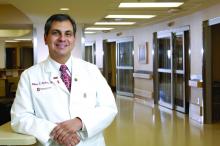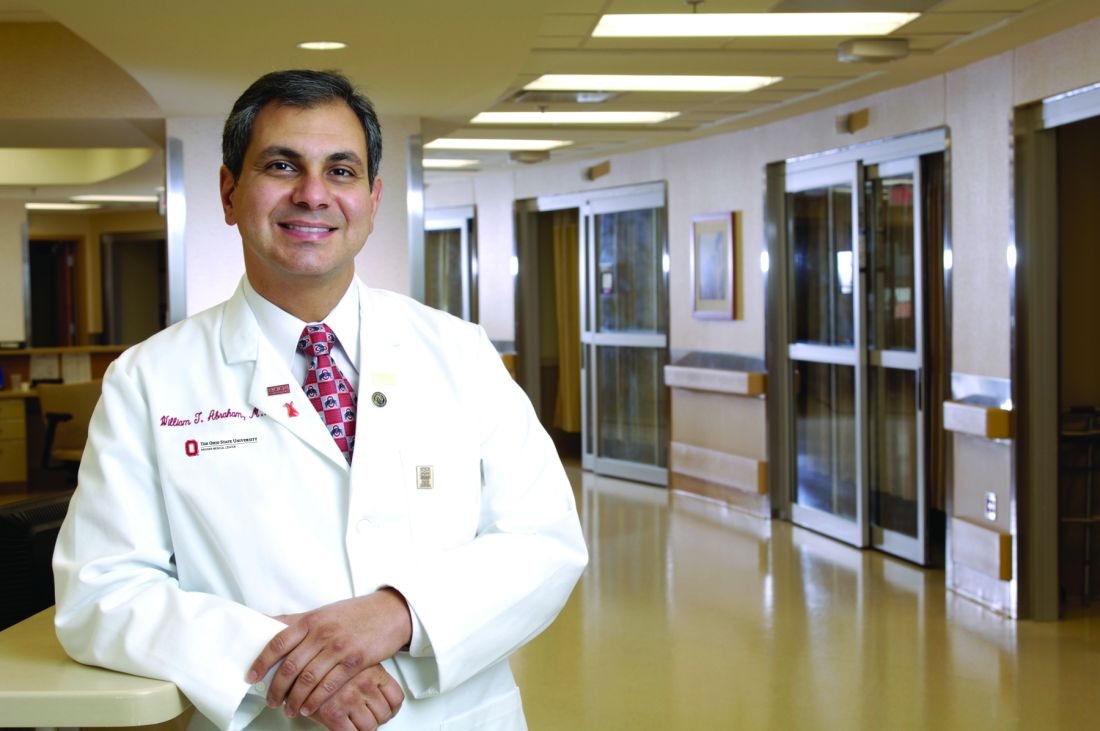User login
BOSTON – Cardiac contractility modulation (CCM), an electrical device–based modality, may improve exercise tolerance and quality of life in heart failure patients with ejection fraction between 25% and 45%, results of a randomized, controlled trial suggested.
Notably, clinical effectiveness appeared to be even greater in the subset of patient with ejection fractions between 35% and 45%, according to results presented at the annual scientific sessions of the Heart Rhythm Society.
The CCM approach was designed to treat chronic heart failure patients with reduced and midrange ejection fractions. It involves the delivery of electrical signals during the cardiac absolute refractory period to enhance contraction strength. Key components include an atrial lead used for sensing and two ventricular leads used for sensing local electrical activity and delivery of CCM signals.
The device was previously evaluated in FIX-HF-5, a 428-patient randomized trial of CCM in patients with New York Heart Association functional class III/IV and reduced ejection fraction. That study failed to meet its primary efficacy end point, but a subgroup analysis showed significant treatment effects in patients with ejection fractions between 25% and 45%.
Consequently, Dr. Abraham initiated the FIX-HF-5 confirmatory study (FIX-HF-5C) to prospectively evaluate CCM in patients with ejection fractions in that range.
The study included 160 with NYHA class III/IV heart failure, QRS duration less than 130 ms, and ejection fractions of 25%-45% who were randomized either to CCM or to continued optimal medical therapy. The control arm included 86 patients, and the CCM arm included 74 patients, of whom 68 received device implantation.
For evaluating peak VO2, the primary end point of this confirmatory study, investigators used a Bayesian model that allowed them incorporate some data from the corresponding subgroup of patients with ejection fractions between 25% and 45% in the previous FIX-HF-5 randomized trial.
Using this model, they found the mean difference between CCM and medical therapy groups at week 24 was 0.836 mL O2/kg per minute (95% Bayesian credible interval, 0.123-1.552). The probability of CCM treatment’s superiority to control was 0.989, according to investigators, which exceeded the 0.975 threshold for statistical significance.
Dr. Abraham and his coinvestigators found that CCM implantation was safe, with a 90% complication-free rate, and that it improved both quality of life and functional status.
All efficacy endpoints were better in patients with ejection fractions of 35% or greater, confirming the subgroup analysis findings of the previous randomized trial, according to Dr. Abraham and his coinvestigators.
Survival free of cardiac death and heart failure hospitalization at 24 weeks was 97.1% in the CCM arm versus 89.2% in controls, which was a secondary finding that reached statistical significance in favor of CCM (P = .048) in one analysis of Kaplan-Meier estimates, investigators said in their report.
The CCM device could fulfill an unmet need for patients who have persistent heart failure despite optimal, guideline-based medical therapy, according to the investigators.
“Although ICDs are applicable to the broad population of patients with ejection fraction [at least] 35%, they do not deliver a therapy for improving exercise tolerance or quality of life,” they said in their report.
Research grant support for the study came from Impulse Dynamics. Dr. Abraham and several coauthors reported serving as consultants to the company.
SOURCE: Abraham WT et al. JACC Heart Fail. 2018 May 10. doi: 10.1016/j.jchf.2018.04.010.
BOSTON – Cardiac contractility modulation (CCM), an electrical device–based modality, may improve exercise tolerance and quality of life in heart failure patients with ejection fraction between 25% and 45%, results of a randomized, controlled trial suggested.
Notably, clinical effectiveness appeared to be even greater in the subset of patient with ejection fractions between 35% and 45%, according to results presented at the annual scientific sessions of the Heart Rhythm Society.
The CCM approach was designed to treat chronic heart failure patients with reduced and midrange ejection fractions. It involves the delivery of electrical signals during the cardiac absolute refractory period to enhance contraction strength. Key components include an atrial lead used for sensing and two ventricular leads used for sensing local electrical activity and delivery of CCM signals.
The device was previously evaluated in FIX-HF-5, a 428-patient randomized trial of CCM in patients with New York Heart Association functional class III/IV and reduced ejection fraction. That study failed to meet its primary efficacy end point, but a subgroup analysis showed significant treatment effects in patients with ejection fractions between 25% and 45%.
Consequently, Dr. Abraham initiated the FIX-HF-5 confirmatory study (FIX-HF-5C) to prospectively evaluate CCM in patients with ejection fractions in that range.
The study included 160 with NYHA class III/IV heart failure, QRS duration less than 130 ms, and ejection fractions of 25%-45% who were randomized either to CCM or to continued optimal medical therapy. The control arm included 86 patients, and the CCM arm included 74 patients, of whom 68 received device implantation.
For evaluating peak VO2, the primary end point of this confirmatory study, investigators used a Bayesian model that allowed them incorporate some data from the corresponding subgroup of patients with ejection fractions between 25% and 45% in the previous FIX-HF-5 randomized trial.
Using this model, they found the mean difference between CCM and medical therapy groups at week 24 was 0.836 mL O2/kg per minute (95% Bayesian credible interval, 0.123-1.552). The probability of CCM treatment’s superiority to control was 0.989, according to investigators, which exceeded the 0.975 threshold for statistical significance.
Dr. Abraham and his coinvestigators found that CCM implantation was safe, with a 90% complication-free rate, and that it improved both quality of life and functional status.
All efficacy endpoints were better in patients with ejection fractions of 35% or greater, confirming the subgroup analysis findings of the previous randomized trial, according to Dr. Abraham and his coinvestigators.
Survival free of cardiac death and heart failure hospitalization at 24 weeks was 97.1% in the CCM arm versus 89.2% in controls, which was a secondary finding that reached statistical significance in favor of CCM (P = .048) in one analysis of Kaplan-Meier estimates, investigators said in their report.
The CCM device could fulfill an unmet need for patients who have persistent heart failure despite optimal, guideline-based medical therapy, according to the investigators.
“Although ICDs are applicable to the broad population of patients with ejection fraction [at least] 35%, they do not deliver a therapy for improving exercise tolerance or quality of life,” they said in their report.
Research grant support for the study came from Impulse Dynamics. Dr. Abraham and several coauthors reported serving as consultants to the company.
SOURCE: Abraham WT et al. JACC Heart Fail. 2018 May 10. doi: 10.1016/j.jchf.2018.04.010.
BOSTON – Cardiac contractility modulation (CCM), an electrical device–based modality, may improve exercise tolerance and quality of life in heart failure patients with ejection fraction between 25% and 45%, results of a randomized, controlled trial suggested.
Notably, clinical effectiveness appeared to be even greater in the subset of patient with ejection fractions between 35% and 45%, according to results presented at the annual scientific sessions of the Heart Rhythm Society.
The CCM approach was designed to treat chronic heart failure patients with reduced and midrange ejection fractions. It involves the delivery of electrical signals during the cardiac absolute refractory period to enhance contraction strength. Key components include an atrial lead used for sensing and two ventricular leads used for sensing local electrical activity and delivery of CCM signals.
The device was previously evaluated in FIX-HF-5, a 428-patient randomized trial of CCM in patients with New York Heart Association functional class III/IV and reduced ejection fraction. That study failed to meet its primary efficacy end point, but a subgroup analysis showed significant treatment effects in patients with ejection fractions between 25% and 45%.
Consequently, Dr. Abraham initiated the FIX-HF-5 confirmatory study (FIX-HF-5C) to prospectively evaluate CCM in patients with ejection fractions in that range.
The study included 160 with NYHA class III/IV heart failure, QRS duration less than 130 ms, and ejection fractions of 25%-45% who were randomized either to CCM or to continued optimal medical therapy. The control arm included 86 patients, and the CCM arm included 74 patients, of whom 68 received device implantation.
For evaluating peak VO2, the primary end point of this confirmatory study, investigators used a Bayesian model that allowed them incorporate some data from the corresponding subgroup of patients with ejection fractions between 25% and 45% in the previous FIX-HF-5 randomized trial.
Using this model, they found the mean difference between CCM and medical therapy groups at week 24 was 0.836 mL O2/kg per minute (95% Bayesian credible interval, 0.123-1.552). The probability of CCM treatment’s superiority to control was 0.989, according to investigators, which exceeded the 0.975 threshold for statistical significance.
Dr. Abraham and his coinvestigators found that CCM implantation was safe, with a 90% complication-free rate, and that it improved both quality of life and functional status.
All efficacy endpoints were better in patients with ejection fractions of 35% or greater, confirming the subgroup analysis findings of the previous randomized trial, according to Dr. Abraham and his coinvestigators.
Survival free of cardiac death and heart failure hospitalization at 24 weeks was 97.1% in the CCM arm versus 89.2% in controls, which was a secondary finding that reached statistical significance in favor of CCM (P = .048) in one analysis of Kaplan-Meier estimates, investigators said in their report.
The CCM device could fulfill an unmet need for patients who have persistent heart failure despite optimal, guideline-based medical therapy, according to the investigators.
“Although ICDs are applicable to the broad population of patients with ejection fraction [at least] 35%, they do not deliver a therapy for improving exercise tolerance or quality of life,” they said in their report.
Research grant support for the study came from Impulse Dynamics. Dr. Abraham and several coauthors reported serving as consultants to the company.
SOURCE: Abraham WT et al. JACC Heart Fail. 2018 May 10. doi: 10.1016/j.jchf.2018.04.010.
REPORTING FROM HEART RHYTHM 2018
Key clinical point: Compared with continued medical therapy, cardiac contractility modulation (CCM) improved exercise tolerance and quality of life in heart failure patients with ejection fraction between 25% and 45%.
Major finding: The difference in peak VO2 between study arms was 0.836 mL O2/kg per minute (95% Bayesian credible interval, 0.123-1.552).
Study details: A randomized controlled trial including 160 patients with NYHA class III/IV heart failure and ejection fraction between 25% and 45%.
Disclosures: Research grant support for the study came from Impulse Dynamics. Several study authors reported serving as consultants to Impulse Dynamics.
Source: Abraham WT et al. JACC Heart Fail. 2018 May 10. doi: 10.1016/j.jchf.2018.04.010.

